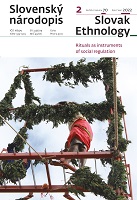Cultural Group Selection and the Russian Old Believers. Adaptive and Maladaptive Outcomes of the Group-Cohesive Effects of Religion
Cultural Group Selection and the Russian Old Believers. Adaptive and Maladaptive Outcomes of the Group-Cohesive Effects of Religion
Author(s): Vladimír BahnaSubject(s): Cultural Anthropology / Ethnology, Social Theory, Sociology of Culture, Sociology of Religion
Published by: SAV - Slovenská akadémia vied - Ústav etnológie a sociálnej antropológie Slovenskej akadémie vied
Keywords: Old Believers; cultural group selection; social cohesion; ritual; religious systems;
Summary/Abstract: Current adaptationist approaches view religion as a system of beliefs, behaviours, social norms, taboos and collective rituals, which enforce social cohesion and intragroup solidarity that lead to group cooperation and coordination. These prosocial effects then translate into success in between-group competition. Cultural group selection is seen as the process that led to the emergence of religion as a cultural adaptation that enables the persistence of cooperative social groups. This article applies this theoretical approach to the so-called Old Believers: a diverse and fractioned branch of Russian Orthodox Christianity, whose history is marked by apocalyptic worldviews and antagonism towards state powers and the Russian Orthodox Church. Since their split with the Russian Orthodox Church in the 17th century, the Old Believers evolved towards egalitarian communities, asceticism, isolationism and traditionalism. The author argues that Old Believers can be in many respects viewed as prototypic examples of how religious systems promote social cohesion, in-group solidarity, identity and commitment. Yet, contrary to what the theory assumes (or at least emphasizes), the very same collective rituals, social norms, supernatural beliefs and taboos, and their systemic interdependence, can lead to group harmful outcomes (e.g., splintering, excessive celibacy, mass suicide). In other words, high levels of in-group prosociality linked to religion cannot be simply viewed as exclusively mediating group benefits.
Journal: Slovenský národopis
- Issue Year: 70/2022
- Issue No: 2
- Page Range: 248-272
- Page Count: 25
- Language: English

